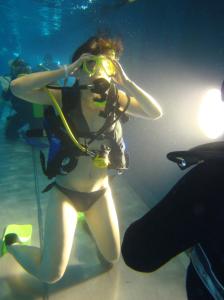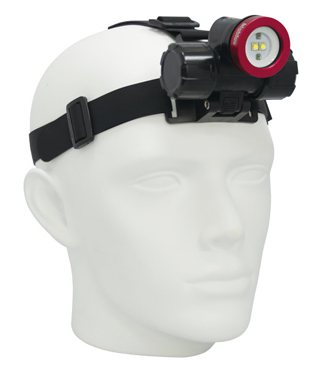Originally Published @ Scuba Scoop 30 August 2014
I wasn’t always calm and controlled underwater. I still remember my initial reaction to the mask flooding skill in the open water course: terror. “Why would I ever put water into my mask on purpose?” I asked my scuba instructor. It sounded crazy. My instructor explained that there was significant value in this skill. Water leaking into a scuba mask is a common occurrence. A diver must become comfortable with water in his mask so that he will maintain control and avoid panic. Situations exist in which a diver may even choose to allow a small amount of water to enter his mask during a dive. For example, swishing a small amount of water around the interior of the mask removes fog from the lenses during a dive. Here are tips on how to overcome the fear of water in the scuba mask.
Fear Management Step 1: Practice Breathing Without a Mask on the Surface:
If the thought of water in the mask scares you silly, your are not alone. The first step in overcoming your fear is to prove to yourself that you can breathe without a mask at all. This step develops confidence that you won’t die underwater without a mask on, and that it is possible to breathe with water surrounding your nose.
Stand, kneel, or sit in shallow water. While breathing from a scuba regulator or a snorkel, but without using a mask, lower your face into the water. Practice breathing slowly and calmly. Inhale and exhale with your mouth. If you feel water entering your nose, breathe in your mouth and out your nose.
Breathing in this manner may feel uncomfortable at first, but stick with it. Remember that you are in control, and that you can lift your face out of the water whenever you like. Practice this skill until breathing though a regulator or snorkel with your face submerged feels routine.
Hint: This skill can even be done with a snorkel in a bathtub at home. With no people watching, there is less pressure from instructors and other students.
Fear Management Step 2: Do “Dry” Runs:
After proving to yourself that you won’t immediately drown when breathing with your nose in the water, you need to develop confidence in your mask clearing skills. Having water in your mask is less scary when you are sure that you can quickly and efficiently remove it.
Underwater (under the supervision of an instructor, if this is your first time) practice the breath control required for mask clearing. Hold the upper frame of the mask against your forehead, look up, and breathe out your nose with a long, slow exhalation. Air should bubble out from the lower portion of the mask. Have an instructor or buddy observe your practice and provide feedback. Practice inhaling with your mouth and breathing out your nose until the breathing pattern is second nature.
Fear Management Step 3: Baby Steps:
When training yourself to become comfortable with water in your mask, put only a small amount of water into the mask at first. Pinch the top seal of the mask gently between two fingers and allow a few drops of water to trickle in. Do not fill the mask to eye-level on your first try. Practice emptying the mask of this tiny amount of water. As you become comfortable, fill the mask more and more until you can comfortably clear a fully flooded mask. Only after becoming confident clearing a fully flooded mask should you practice removing the mask and replacing it underwater.
Fear Management Step 4: Practice Repetitively in Calm, Shallow Water:
Before hitting the ocean (or even the deep end of the pool) practice allowing water into your mask and blowing it out until you are bored with the skill. Practice clearing the mask of water in different positions: swimming, hovering, laying on the floor, etc. The point is to make this simple skill routine, and to gain muscle memory. Once you can preform the skill mindlessly you will no longer panic when water enters your mask. Your immediate reaction to water in your mask will be to calmly and efficiently blow the water out. However, multiple repetitions are required to reach this level of proficiency.
Fear Management Step 5: Put Water in Your Mask on Every Dive — On Purpose!:
The key to mastering scuba diving skills is repetition and practice. A proficient diver can execute diving skills automatically without fear or hesitation. Of course, many diving skills require a series of steps which must be practiced deliberately at first, but with repeated practice, even a complicated skill becomes automatic.
With this in mind, consider that your work is not done once you have become comfortable with water in your mask. Even if you have overcome your fear, you must periodically reinforce your confidence by allowing water into your mask and clearing it. A diver who is nervous about water in his mask should purposefully flood his mask on every dive. Not only does he reinforce the skill (See, I can still do it!) but repetition over a long period of time will strengthen his muscle memory and ensure that he reacts properly in an unexpected situation.
Fear Management Step 6: Mind Games:
I finally became very comfortable with water in my mask during my Divemaster course, during which I was asked to demonstrate mask removal and clearing and make it look easy and fun. I learned an interesting mind trick – when I had the mindset of demonstrating (or showing off) I lost any residual fear of water in my mask and instead focused my energy on how to look professional. How slowly could I clear my mask? How controlled? Could I maintain buoyancy and trim (body position) while demonstrating? By taking the focus off of “Aughhh, there is water in my mask!” and instead focusing on making the skill look good, the fear of water in the mask was replaced by fear of looking like an idiot. I sometimes recommend this mind trick to students. I ask them to imagine they are demonstrating the skill for a diver who is even more afraid of water in the mask than they are, and try to make it look like no big deal. It doesn’t work for everyone, but this mind trick worked for me!
The Final Word on Getting Over the Fear of Water in the Mask:
As in most scary situations in life, the best way to overcome the fear of water in your mask is to face the situation, not ignore it. A person who is scared of water entering his mask is unlikely to react properly in the event that his mask floods during a dive. He may bolt for the surface or panic underwater, either of which is unsafe. Work your way up to putting water in your mask by proving to yourself that you can breathe safely on the surface with no mask, and that you can breathe out your nose to clear a mask properly. Then, begin with small amounts of water and practice repetitively until you are bored before adding more water to the mask. Work at your own pace and do not push yourself into a panic situation. Take it easy – with time and patience you can overcome this fear. Once you become confident clearing the mask, practice mask flooding or mask removal with a buddy on every dive to keep the skill (and your confidence) fresh.
Thanks to Natalie Gibb @ About sports
Kathy Dowsett
www.kirkscubagear.com







Leave A Comment